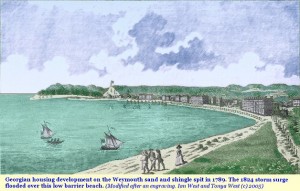Vanessa here,
When reading Regencies, I love getting into the environment, learning about the land, flowers, etc. I even love being immersed in the weather.
Weather Vanessa? Really?
Now some might look at weather as just a scenery element, purring at the way the moonlight beams in the hero’s eyes or the soft bounce of sun reflecting in the heroine’s hair. Yet, weather can be a force to reckon, a third character changing the course of events.
Haven’t you read about the snows of the yuletide keeping the family in the country as opposed to rushing back to London or the occasional rainstorm trapping the hero and heroine. You may have even read about 1816, the year with no summer.
Yet, England like most places, experienced much more. For an upcoming novella project, I began looking for windstorms that savaged my Regency World.
After much research, I came across two events: March 4, 1818 and April 26, 1818. The gale of March 4 raged all over England but it also knocked over several buildings in London. The tornado of April 26 focused on the southern coast.
The Gale of March 4
The gale raged on the 4th, 7th and the 8th. The gale was more likely an offshoot of a coastal hurricane, but its reach was massive. Moreover, the respite in between the 4th and the 7th fooled people into thinking the worst was over.
Here are some quotes on the event:
“Storm across southern Britain caused considerable damage around Nottingham, uprooting trees, blowing slates off roofs etc. At Leicester and Mansfield … the storm was very violent, and attended with similar effects to those experienced in this town”.
A Douglas paper of March 5th, that year, says : — “We have not for many years witnessed so tremendous a storm as last night struck terror into every bosom and, carried havoc and devastation in its train.”
“It had been thundering ; and lightning and blowing strong for several days previously, and consequently the harbour at Douglas was crowded with shipping of all sizes. On Wednesday, the 4th, the wind stood at sou’-west, but at night it suddenly veered to sou’-east, and then blew a hurricane. Scarcely a vessel in the port escaped.”
“Neither cable nor post resisted the storm the very posts in the quay were dragged cut.”
“A brig, Samuel, of Whitehaven, entered the harbour, and, driven by the gale, crashed into the other vessels. Then ensued crashing and smashing and fearful confusion — masts and bowsprits snapped, bows and sterns stove in, bulwarks smashed. Two boats were actually sunk; no lives lost, but many persons were injured. The quays were crowded with people, and everyone who had a lantern brought it to the quayside.”
Hurricane of 1824
The Devon and Dorset coasts endured a savaging hurricane November 22 through the 23rd. Floodwaters were over 2 meters (6.5 feet).

In Hertfordshire, a tornado (offshoot from the hurricane) was described as “a white whirling cone uprooted many trees and unroofed houses.”
A naval officer at Sidmouth at the time said, “The wind was stronger than the West Indian hurricanes. The noise of the wind was like incessant Thunder, but there was something in it still more aweful and supernatural. It seemed to rage so perfectly without control – so wild and free that nothing I ever heard before could be at all compared to it.”
Others reported, “The noise of the wind was remarkable and that it howled or roared in the great gusts. Chimneys were blown down and stone church buildings were damaged. Roofs of shops were carried away. The unusual force of the rain and hail broke a huge number of windows.”

“At 6 am on Tuesday 23rd, the time of the overwash at Chiswell, a heavy stack of chimneys was blown down, killing the Reverend H.J. Richman and his wife.”
Some other accounts of damage are:
- 19 boats destroyed
- 200,000 tons of stone moved by the storm
- Ships washed onto farmland
- Over 80 houses smashed
- Coastal town after town flooded
- Over 50 people died
After this research, I think 1818 should be nicknamed, “The Year With Wind.”
References:
http://www.phenomena.org.uk/page29/page46/page46.html
http://www.southampton.ac.uk/~imw/jpg-Chesil/5CH-1824-Hurricane-map.jpg
http://www.isle-of-man.com/manxnotebook/fulltext/mxa1901/ch09.htm
Other Weather Related Posts:
The Regency Weather Forecaster
The Year Without a Summer
Home for the (Summer) Holidays
The Final Frost Fair: What Do You Do When the Thames Freezes Over?
The First Signs of Autumn
Originally posted 2014-06-09 09:00:00.
Comments are closed.